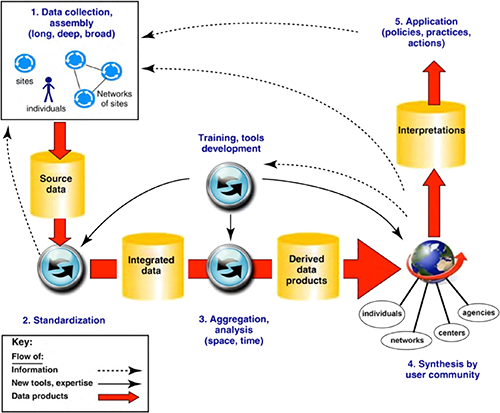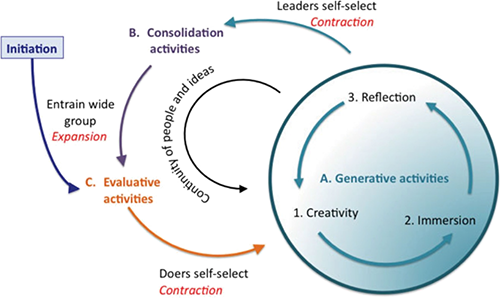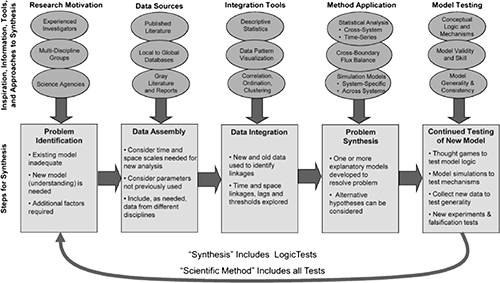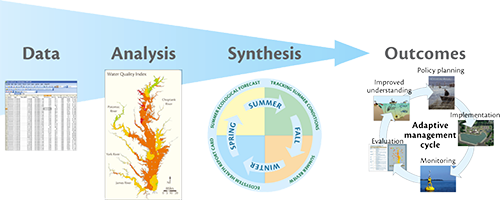Scientific synthesis at the University of Maryland Center for Environmental Science: Part 1--Overview
Bill Dennison ·This post is part one of a four part series on scientific synthesis.
The word synthesis is derived from the Greek word, syntithenai meaning 'to put together', and was first used in the latter part of the 1500s. The word integration is derived from the Latin word, integratus meaning 'to render whole', and was first used in the early 1600s. In the context of scientific synthesis or integration, the definition of these two words converge. Scientific synthesis can be defined as "The inferential process whereby new models are developed from analysis of multiple data sets to explain observed patterns across a range of time and space scales" (Kemp and Boynton, 2011). The importance of synthesis and integration in scholarship was emphasized in Boyer's (1990) seminal book 'Scholarship Reconsidered: Priorities of the Professoriate', in which he defined scholarship as discovery, integration, application and teaching.
The University of Maryland Center for Environmental Science has embraced the Boyer concept of scholarship and has included these four tenets of scholarship in tenure and promotion evaluations. In order to promote scientific integration and application at UMCES, the Integration and Application Network was created in 2002. In 2011, UMCES joined up with the University of Maryland, College Park and Resources for the Future to create the National Socio-Environmental Synthesis Center, funded by the National Science Foundation. But more importantly, throughout its history, beginning in 1925, UMCES scientists have been integrating (and applying) scientific results in Chesapeake Bay and throughout the world. For example, a recent publication co-authored by two UMCES scientists, Michael Kemp and Walter Boynton, provides a thoughtful review of the synthesis process: 'Synthesis in estuarine and coastal ecological research: What is it, why is it important, and how do we teach it?' (Kemp and Boynton, 2012).
Two recent trends in science have promoted synthesis efforts. One trend is the discussion of the scholarship of synthesis in the scientific literature (e.g., Hampton and Parker, 2011; Kemp and Boynton, 2012; Peters, 2010; Sidlauskas et al., 2009; Thompson et al., 2011). The other trend is in the proliferation of synthesis centers, created expressly to stimulate synthesis efforts (e.g., NCEAS, NESCent, NIMBioS, ACEAS, SESYNC). Each of these trends will be summarized in turn.

The emerging literature on scientific synthesis has led to attempts to identify a series of steps to define the process of synthesis. Peters (2010) defines the five synthesis steps as the following; 1) Data collection & assembly, 2) Standardization, 3) Aggregation and analysis, 4) Synthesis, and 5) Application. Thompson et al. (2011) define three synthesis steps as the following: A) Generative activities (creativity, immersion, reflection), B) Consolidation activities (community of people and ideas), and C) Evaluative activities (entrain wide group). Kemp and Boynton (2012) outline a five step synthesis process as the following: 1) Identify challenging science problem, 2) Assemble relevant data, 3) Integrate data by identifying linkages among units, 4) Define alternative models that explain or test problem, and 5) Select simplest model that maximizes explanation. Each of these models provides an iterative cycle of converting data into information and ultimately into synthesized knowledge.



There are various professional and social skills needed for conducting synthesis research (Kemp and Boynton, 2012). Professional skills include tested native intelligence, expertise in a specific research area, critical and logical thinker, pattern recognition and visualization, quantitative skills (statistics, models, data management), writing and speaking skills. Social skills include inquisitive attitude, willingness to develop and try new ideas, tolerance and respect for unusual ideas, interest in “big picture” issues, team orientation with interdisciplinary knowledge, good listener and open minded, willingness to share (ideas, data and publications), and constructive criticism.
Kemp and Boynton (2012) also identify a suite of mental exercises to build synthesis skills: search for unconventional but general explanation, use isomorphisms, homologies, and analogies, tackle hard problems but avoid impossible ones, develop conceptual models with links and causality, use consistent time, space and complexity scales, broaden knowledge base, work in team oriented interdisciplinary groups, look for the big picture and find the “macoscope”, develop diverse quantitative skills and study many synthesis examples.
The proliferation of synthesis centers was stimulated by the success of the National Center for Ecological Analysis and Synthesis (NCEAS). NCEAS was created in 1995 by the University of California, Santa Barbara, funded by the National Science Foundation with matching funds from the State of California and University of California system. NCEAS is located in downtown Santa Barbara and researchers using this center have generated an impressive number of high impact scientific papers. There are several important lessons in conducting synthesis that NCEAS has learned over the years, summarized in Hampton and Parker (2011). NCEAS encourages synthesis working groups to a) encourage diverse viewpoints, b) manage the power relationships within working groups, c) provide incentives for individual groups members, d) establish clear expectations, e) build group cohesion, and f) order the discussion. In analyzing the trends in NCEAS working group composition and activity, the average working group was 13 scientists, gathering for ca. one week on 4 occasions every 8-9 months. The average NCEAS paper had 6 co-authors. NCEAS emphasized the value in face-to-face interactions for the following reasons: a) transmission of tacit knowledge, b) role and identify formation, c) communication, d) development of trust, cohesion and commitment, e) creating a sense of gravitas, and f) expectations of quality.
The next National Science Foundation synthesis center to be created was the National Evolutionary Synthesis Center (NESCent). This synthesis center was founded in 2004 in Durham and is run by a three university consortium; Duke University, University of North Carolina and North Carolina State University. NESCent promotes the synthesis of information, concepts and knowledge to address significant, emerging, or novel questions in evolutionary science and its applications.
The National Institute for Mathematical and Biological Synthesis (NIMBioS) was founded in 2008, also funded by the National Science Foundation. NIMBioS is located in Knoxville, and is run by the University of Tennessee. NIMBioS explores the interface between math and biology.
The Australian Centre for Ecological Analysis and Synthesis (ACEAS) is a facility within the Terrestrial Ecosystem Research Network (TERN), which is supported by the Australian government. ACEAS was founded in 2010, modeled after NCEAS, although they do not have a fixed location for synthesis meetings and generally only support 2 working group meetings, instead of the typical 4 meetings supported by NCEAS. ACEAS is run by the University of Queensland in Brisbane, Australia.
The National Socio-Environmental Synthesis Center (SESYNC) was founded in 2011, and is located in Annapolis, Maryland. It is funded by the National Science Foundation and is administered by the University of Maryland. The mission of SESYNC is to foster synthetic, actionable scholarship related to the structure, functioning, and sustainability of socio-environmental systems.
In addition to these national synthesis centers, the Integration and Application Network, University of Maryland Center for Environmental Science promotes science synthesis through science communication tools (e.g., image and symbol libraries, online conceptual diagram creator, science communication courses) and environmental report cards. An active team of Science Integrators and Science Communicators work with a variety of partners regionally, nationally and globally to develop scientific synthesis. Funding for IAN is through grants and contracts.

References
Boyer, EL. 1990. Scholarship reconsidered: Priorities of the professoriate. Carnegie Foundation. 147 pp.
Hampton SE & JN Parker. 2011. Collaboration and productivity in scientific synthesis. Bioscience 61: 900-910.
Kemp WM & WR Boynton. 2012. Synthesis in estuarine and coastal ecological research: What is it, why is it important, and how do we teach it? Estuaries and Coasts 35: 1-22.
Peters, DPC. 2010. Accessible ecology: Synthesis of the long, deep, and broad. Trends in Ecology and Evolution 25: 592-601.
Sidlauskas B, G Ganapathy, E Hazkani-Covo, KP Jenkins, H Lapp, LW McCall, S Price, R Scherle, PA Spaeth, DW Kidd. 2009. Linking big: The continuing promise of evolutionary synthesis. Evolution 64: 871-880.
Thompson SE, CJ Harman, R Schumer, JS Wilson, NB Basu, PD Brooks, SD Donner, MA Hassan, AI Packman, PSC Rao, PA Troch, M Sivapalan. 2011. Patterns, puzzles and people: Implementing hydrologic synthesis. Hydrological Processes 25: 3256-3266.
About the author
Bill Dennison

Dr. Bill Dennison is a Professor of Marine Science and Interim President at the University of Maryland Center for Environmental Science (UMCES).
Next Post > Teaching with a ‘flipped classroom’ over an interactive video network
Comments
-
Atika 5 months ago
Thank you for sharing this great information with us, i really appreciate your post!